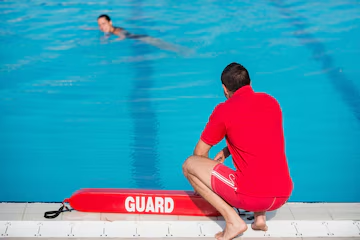Lifeguarding is a difficult profession demanding physical stamina, keen observation, and fast emergency response-ability. Although most lifeguard programs emphasize water rescue methods, CPR, and first aid, one important element that usually gets forgotten is heat safety. Working long hours under the sun can expose one to heat-related diseases that would compromise a lifeguard’s capacity to carry out their responsibilities successfully.
We will look in this post crucial heat safety advice for lifeguards, the hazards of heat exposure, and how good training—such programs provided by the American Lifeguard Association—can equip lifeguards to remain safe in hot surroundings.
Why Heat Safety Is Vital for Lifeguards
For most of their shifts, lifeguards are in direct sunlight with sometimes little cover. Long-term contact with elevated temperatures can cause:
- Dehydration is sweating’s loss of liquids in the absence of sufficient water intake.
- Electrolyte loss causes agonizing muscular spasms known as heat cramps.
- Heat exhaustion symptoms include lightheadedness, nausea, headache, and quick pulse.
- Heatstroke is a life-– condition in which the body can no longer control its temperature.
Heat-related exhaustion can impair lifeguards’ capacity to react to crises because they have to stay vigilant at all times. Good training includes rules on spotting and avoiding heat stress, such as that given in American Lifeguard Association lifeguard programs.
Best heat safety advice for lifeguards
1. Quenched Stay
One of the major hazards for lifeguards is dehydration. Even slight dehydration might slow reaction time and focus.
- Drink water often; even if you aren’t thirsty, aim for at least 8 ounces every 20 to 30 minutes.
- Caffeinated and sugary drinks should be avoided; these might aggravate dehydration.
- Light yellow denotes adequate hydration; dark yellow indicates dehydration. Pay attention to urine colour.
2. Don Suitable Sun Protection
Sunburn raises the chance of heat exhaustion in addition to harming the skin.
Use broad-spectrum sunscreen (SPF 30+); reapply every two hours, particularly after swimming or sweating.
- Wear UV-protective sunglasses and a wide-brimmed hat; these will keep your eyes and face shielded from bad rays.
- Opt for lightweight, breathable apparel; long-sleeved rash guards with UPF protection will keep you cool while also helping to prevent sunburn.
3. Enjoy frequent pauses in the shade.
Continuous sun exposure can cause overheating even with hydration and sunscreen.
- If feasible, alternate between shaded and high-exposure positions.
- Many lifeguard towers now provide pop-up shade choices or umbrellas.
- Observe OSHA rules for heat breaks; little, regular breaks in a cool setting help to control body temperature.
4. Understand the indicators of heat-related diseases.
Lifeguards have to be savvy in spotting signs of heat stress in other people as well as in themselves.
Cramps from heat
- Usually in the abdomen or legs, muscle discomfort or spasms
- Action: Drink water or a sports drink containing electrolytes while resting in a cool area.
Heat Exhaustion
- headache, nausea, dizziness, weakness, heavy sweating
- Action: Loosen clothing, cool compresses, sip water, and move to a cooler environment.
Heatstroke (Medical Crisis)
- High body temperature (103°F+), confusion, loss of consciousness, quick pulse.
- Action: Call 911 right away, go to shade, cool the body with ice packs or water, and keep an eye on until assistance arrives.
Good lifeguard training — such as those from the American Lifeguard Association—guarantees lifeguards can act quickly in heat crises by teaching these identification and response strategies.
5. Adapt to the Heat
New lifeguards or those coming back after a hiatus should slowly acclimate to working in sweltering conditions.
- Begin with shorter shifts; raise exposure over one to two weeks.
- Pay attention to how your body responds; some people acclimate more quickly than others.
6. Have small, nutritious meals.
Heavy, greasy cuisine might make you feel lethargic in the sweltering heat.
Choose fruits, vegetables, and lean meats; these give energy without overloading your body.
Snack on foods high in water; oranges, cucumbers, and watermelon help to sustain fluid levels.
7. Apply cooling gadgets.
Creative products let lifeguards keep cool:
- Soak in cold water and hang around the neck cooling towels.
- Portable misting fans offer peak heat instant relief.
Some lifeguards employ these in extreme situations.
How Lifeguard courses Equip You for Heat Safety
Although most lifeguard training focuses on water rescue techniques, top-notch programs like those from the American Lifeguard Association also include heat safety instruction. This includes:
- Understanding in yourself and others indicators of heart illness.
- Adequate hydration plans pre-, per, and post-work.
- Protocols for responding to heatstroke victims in emergencies.
Understanding how heat affects performance is especially important given the need for lifeguards to stay alert. Good training guarantees one to stay calm under pressure—literally.
Last Reflections
An essential but sometimes disregarded part of lifeguarding is heat safety. Lifeguards can shield themselves while ensuring swimmers are safe by remaining hydrated, using sun protection, noting heat-related diseases, and taking breaks.
Those thinking about getting ALA lifeguard certification should select a thorough program—like the American Lifeguard Association’s lifeguard courses—to guarantee they are ready for all parts of the work.
Stay calm, watch yourself, and be safe!


